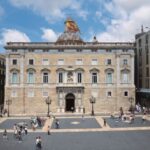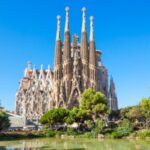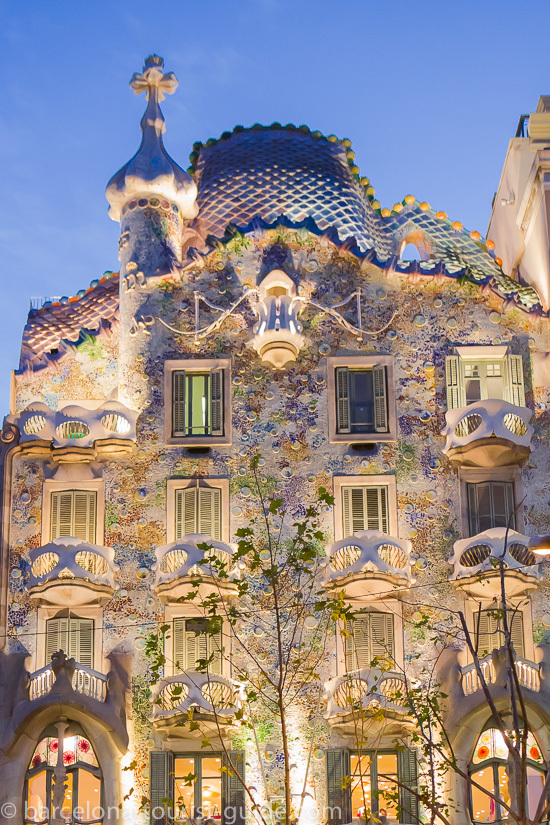
Barcelona, a city renowned for its rich cultural heritage and architectural marvels, boasts a variety of iconic structures that reflect its unique identity. Among these, two masterpieces stand out: Casa Batlló and the Sagrada Familia. These landmarks not only showcase the genius of Antoni Gaudí but also embody the spirit of modernisme in Catalonia.
In exploring **Barcelona's Iconic Landmarks: Casa Batlló and Sagrada Familia**, visitors are transported into a realm of creativity where nature and architecture intertwine. Both sites attract millions of tourists each year, drawing admiration for their intricate designs and profound symbolism, making them essential stops for anyone wishing to experience the essence of Barcelona.
Exploring Gaudí's Masterpieces: Casa Batlló and Sagrada Familia
Exploring Gaudí's masterpieces in Barcelona leads to a deep appreciation of his innovative architectural style. Casa Batlló, with its vibrant colors and organic shapes, is often referred to as a "living architecture." Its façade, adorned with mosaic tiles and unique balconies resembling masks, encapsulates Gaudí's vision of blending art with nature. The interior is no less impressive, featuring flowing lines and elements inspired by marine life.
The Sagrada Familia, perhaps Gaudí's most ambitious project, represents a synthesis of Gothic and Art Nouveau styles. This breathtaking basilica, still under construction, has been a labor of love for over a century. Visitors can marvel at its intricate towers, each symbolizing a different aspect of Christianity, and the stunning stained glass windows that cast colorful light throughout the interior.
- Casa Batlló: A testament to creativity with its whimsical design.
- Sagrada Familia: A symbol of faith that continues to evolve.
- Both structures exemplify Gaudí's ability to harmonize architecture with nature.
Both Casa Batlló and the Sagrada Familia encapsulate the spirit of Barcelona, inviting visitors to explore the boundaries of imagination and craftsmanship. Together, they offer a glimpse into Gaudí's visionary approach, making them essential landmarks for anyone exploring the rich cultural heritage of this vibrant city.
The Architectural Significance of Casa Batlló in Barcelona
Casa Batlló stands as a remarkable testament to Antoni Gaudí's architectural genius, embodying the essence of Catalan modernisme. Its façade, characterized by undulating forms and vibrant colors, invites viewers to appreciate how architecture can mimic the fluidity of nature. Gaudí's innovative use of materials such as ceramics and glass adds to the building's mesmerizing appearance, making it a cornerstone of Barcelona's architectural landscape.
The structural design of Casa Batlló is equally significant, showcasing Gaudí's ability to blend functionality with aesthetics. The building's interior is a marvel of spatial organization, with flowing corridors and light-filled spaces that create a sense of harmony. Natural light plays a crucial role, as large windows and skylights are strategically placed to enhance the overall ambiance. This thoughtful integration of light demonstrates Gaudí's commitment to creating a living environment.
- Organic Shapes: The building features curved lines that evoke natural forms, moving away from traditional straight angles.
- Mosaic Tile Work: The colorful ceramic tiles reflect Gaudí's love for nature and his innovative techniques in façade design.
- Symbolism: The structure is rich with symbolic references, including the dragon's back, representing the legend of Saint George.
Furthermore, Casa Batlló's significance extends beyond its aesthetic appeal; it serves as a cultural icon, representing Barcelona's artistic spirit. Visitors are drawn to its unique interpretation of modernisme, making it an essential part of the city's identity. Engaging with Casa Batlló allows one to experience not just a building, but a living piece of art that continually inspires and captivates.
Sagrada Familia: A Journey Through Gaudí's Vision and Legacy
The Sagrada Familia, a true embodiment of Antoni Gaudí's architectural vision, is as much a spiritual journey as it is a visual delight. This monumental basilica stands as a testament to Gaudí's deep religious faith and his desire to create a space that transcends traditional architectural boundaries. Its intricate design elements and towering facades invite visitors to explore the connection between faith and artistry.
Visitors are often captivated by the profound symbolism woven throughout the Sagrada Familia, such as:
- The Nativity Facade: Celebrating the birth of Jesus, adorned with detailed sculptures depicting biblical scenes.
- The Passion Facade: A stark contrast, illustrating the suffering of Christ with sharp, angular forms.
- The Glory Facade: A future-facing tribute to the resurrection, emphasizing light and grandeur.
One of the most innovative aspects of the Sagrada Familia is Gaudí's use of natural forms and structures, which are reflected in its columns and arches that resemble trees in a forest. This organic approach not only enhances the aesthetic appeal but also symbolizes the unity between nature and spirituality. The basilica's design encourages contemplation, making it a profound space for reflection and connection.
As the Sagrada Familia continues to evolve, it serves as a living monument to Gaudí's legacy and vision. Each stone laid adds to the ongoing narrative of faith, art, and dedication, ensuring that visitors experience both the past and the future of this remarkable project. The basilica, once completed, will stand as a crown jewel in Barcelona's architectural landscape, forever celebrating Gaudí's genius.
Casa Batlló vs. Sagrada Familia: Comparing Barcelona's Iconic Landmarks
When comparing Casa Batlló and the Sagrada Familia, one can see how both landmarks encapsulate Antoni Gaudí's architectural genius through their distinct yet complementary styles. Casa Batlló, known for its vibrant facade and organic forms, is a celebration of color and creativity, often likened to a living organism. In contrast, the Sagrada Familia represents a grand narrative of spirituality and faith, combining Gothic elements with innovative techniques to create an awe-inspiring structure that towers over the cityscape.
Architecturally, Casa Batlló offers a sensory experience with its curvilinear shapes and intricate details that draw inspiration from nature. Visitors are often enchanted by features such as:
- Whimsical Balconies: Resembling masks, they add character and charm to the building.
- Colorful Mosaic Tiles: Reflecting Gaudí's passion for nature, they create a stunning visual impact.
By contrast, the Sagrada Familia's complexity lies in its towering spires and intricate facades, each telling a story of biblical significance. The basilica's design is also characterized by:
- Naturalistic Columns: Designed to mimic trees, they create a forest-like atmosphere inside.
- Stained Glass Windows: Casting ethereal light that enhances the spiritual ambiance of the interior.
While both Casa Batlló and the Sagrada Familia are masterpieces of modernisme, they reflect different aspects of Gaudí's vision. Casa Batlló invites visitors to experience a world of whimsy and imagination, while the Sagrada Familia offers a profound encounter with faith and artistry. Together, they illustrate the incredible range of Gaudí’s creativity and his ability to blend architecture with the essence of life itself.
Tips for Visiting Casa Batlló and Sagrada Familia in Barcelona
When planning your visit to Casa Batlló and the Sagrada Familia, consider purchasing tickets online in advance to avoid long queues. Both landmarks are immensely popular, attracting thousands of visitors each day. By securing your tickets ahead of time, you can maximize your experience and spend more time exploring the intricate details that make these sites so unique.
Another essential tip is to time your visit wisely. Early mornings or late afternoons tend to be less crowded, providing a more intimate atmosphere to appreciate the architectural wonders. Additionally, consider visiting on weekdays rather than weekends, as local crowds can significantly increase during peak tourist times. This strategy allows for a more leisurely exploration of both Casa Batlló and the Sagrada Familia.
While exploring Casa Batlló, take advantage of the audio guide provided, which offers in-depth insights into the building's history and design. The audio experience enriches your understanding of Gaudí's vision and the symbolism behind various elements. Similarly, as you wander through the Sagrada Familia, engaging with the exhibits and informational displays can enhance your appreciation of this ongoing masterpiece.
Finally, don't forget to allocate time for the surrounding areas. The neighborhoods near both landmarks, such as the Eixample for Casa Batlló and the Ensanche for the Sagrada Familia, offer delightful cafés, shops, and parks. Enjoying a meal or coffee after your visits can provide a perfect opportunity to reflect on your experiences and soak in the vibrant atmosphere of Barcelona.
Historical Context of Barcelona's Iconic Landmarks: Casa Batlló and Sagrada Familia
The historical context of Barcelona's architectural landmarks reveals a city in transformation during the late 19th and early 20th centuries. The rise of the modernisme movement, characterized by its embrace of innovation and creativity, provided the perfect backdrop for Gaudí's masterpieces. **Casa Batlló** and the **Sagrada Familia** emerged as symbols of this cultural renaissance, reflecting the aspirations of a society eager to break away from traditional norms and embrace a new artistic identity.
Both Casa Batlló and the Sagrada Familia were commissioned by influential families and organizations seeking to showcase their status through distinctive architecture. This era saw a surge in investment in urban development, leading to the creation of iconic structures that not only defined the city’s skyline but also its cultural heritage. Key factors contributing to their significance include:
- Industrial Growth: The economic boom allowed wealthy patrons to commission bold architectural projects.
- Sociopolitical Change: A movement towards Catalan nationalism inspired the artists and architects of the time.
- Architectural Experimentation: Gaudí’s use of natural forms and innovative materials set a new standard in architecture.
While Casa Batlló was completed in 1906, the Sagrada Familia remains a work in progress, started in 1882 and expected to be completed in the coming years. The contrast between the two illustrates a unique narrative of Barcelona’s architectural evolution. Casa Batlló's whimsical design reflects a playful approach to modernisme, whereas the Sagrada Familia stands as a monumental testament to endurance and spiritual dedication. Both structures are essential to understanding the development of Barcelona's cultural identity.
In summary, the historical significance of these landmarks is anchored in their representation of a vibrant sociocultural landscape. They encapsulate the artistic ambitions of their time and continue to inspire awe today. By exploring Casa Batlló and the Sagrada Familia, one can appreciate not only Gaudí's genius but also the dynamic history of Barcelona itself.
 Explore Barcelona Cathedral and Plaça Sant Jaume
Explore Barcelona Cathedral and Plaça Sant Jaume Vintage Gin & Tonic Bar - Specializing in classic cocktails with a stylish, retro vibe.
Vintage Gin & Tonic Bar - Specializing in classic cocktails with a stylish, retro vibe. The Architectural Marvel: Gaudi's Sagrada Familia Undergoing Reform in Barcelona
The Architectural Marvel: Gaudi's Sagrada Familia Undergoing Reform in BarcelonaIf you want to know other articles similar to Barcelona's Iconic Landmarks: Casa Batlló and Sagrada Familia you can visit the category WHERE YOU CAN GO.
Leave a Reply










Read more!